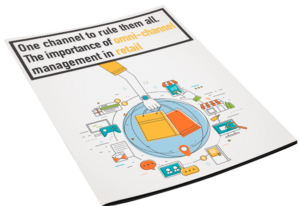What a year of change this has been! Tech is more and more important in-store, mobile keeps on growing, and a previously iconic large retail chain has disappeared from the high street due to its inability to develop an omni-channel presence. These have been eye-openers for many retailers: the only alternative to being omni-channel will soon be closing your shop’s doors.
Creating a true omni-channel experience, however, is not as simple and quick as developing a website and a mobile app alongside the physical stores.
According to research from Google, 98 percent of Americans switch between devices in the same day. This happens when researching information as well as when making purchases. This means that today, the average shopping journey embraces various channels: a consumer may look for a coffee machine or a shampoo on your website, order it via mobile while on his commute home, and finally choose to pick the item up in-store the next day.
To support the new customer journey, your channels need to be connected, creating a coherent, meaningful experience for the consumer.
But how to do so? We have looked at what retailers with a successful omni-channel strategy get right, and put together seven tips.
1. Be consistent
Make sure that your customers get a unified experience of your brand, whichever touchpoint they come through. Keep your brand image consistent in-store, on your website, loyalty app and on social media, and give the same quality of service across the channels.
If your offline presence is hip, youthful and colorful, but your app is dull and offers few options to interact with the products; if you emphasize customer service in-store, but then do not respond timely to customer queries on Facebook – you will lose customers.
2. Make sure your channels are integrated
Can shoppers jump across your channels easily? Customers today want to be able to check on your website if that purple jacket is available in your downtown store in size M; to find in your webstore that sapphire bracelet they saw in your shop while they were on holiday; to drop in one of your physical locations to exchange the too-tight shoes they bought in your online store.
These are common demands; and yet, your channels must be totally integrated to be able to offer all that. Retailers using disparate, badly-connected solutions often have a hard time tracking their inventory – and end up selling items they don’t have, and being unable to offer highly in-demand services like click & collect and online inventory search.
There is a solution: end-to-end retail management systems like LS Nav enable you to control your whole inventory centrally, so you always know how many items are still available, where they are located exactly, and can easily accept exchanges and returns in your whole retail network.
3. Be transparent
Are all your sales conditions clear and visible in your website? Research shows that seventy percent of online shoppers abandon their shopping cart before completing the purchase – a frequent cause being unclear or excessive shipping costs.
Create a trust relationship with your customers, and be upfront about shipping prices and times, shipment restrictions and special conditions. Clearly state the product specs: buying a deceivingly labeled item may perhaps lead to the latest funny viral post, but it sure doesn’t help build a returning clientele.
4. Work on your online inventory
According to Forrester research, 71% of customers expect to access in-store inventory online. This feature is so important to consumers that 2 out of 5 are unlikely or very unlikely to visit a retailer’s store that does not offer it.
Your product list, online and in the app, should tick all these boxes:
- Complete and updated, allowing customers to see where the product they want – in the right variants: color, size… – is available. You can make sure that your product list is always up-to-date across all your channels by using an integrated management system. All changes (to product availability, specs, price, and offers) will need to be made only once centrally; the system then automatically updates all instances across in your e-commerce site, app, store back-office and POS.
- With detailed product information. Do not forget to include, if applicable, materials (or ingredients), special care warnings, warranty information and special return policies. If you stock similar products, make sure you give your customers enough info to allow them to make an informed choice.
- With clear, high-quality pictures. According to Forbes, 67% of consumers find product imagesvery important when it comes to selecting and purchasing a product.
5. Put customer needs at the heart of your strategy
You can’t expect consumers to come to you; you must make sure that you are there when they need you. People live most of their life with a computer (be it a tablet, a phone or a pc) in their hands. As a retailer, you need to identify moments of opportunity in the customer journey, and make sure to be present. If you help consumers and solve their problems, they will pay you back with their trust and business.
Take, for example, American pharmacy and health care company CVS/Health. The company designed their app with the goal of solving a common problem: managing complex medication schedules. Users can use the app to set up reminders to take medicines; the reminders can even be loaded onto an Apple watch. When they enter a CVS/Health pharmacy, a notification advises app users that their medications are ready for pickup. This app is designed to provide consumers with a service – not merely to sell more.
6. Use that data
Capture your customers’ data, and turn this information into action. E-commerce sites and apps create a wealth of information: use it to improve the overall retail strategy. For example, use data on your customers’ shopping habits to determine the best location for a new physical store, or the right product mix for each of your locations.
When it comes to collecting and using customer information, it’s important to have well-integrated systems in place. According to a study by Forrester Research, most companies only analyze a puny 12% of the data they have. Repressive silos, which lead to fragmented, hard-to-access data, are to blame for this untapped potential, says Forrester. Smash the information silos, let data flow across your whole organization and create a complete, unified view of the customers across your channels.
7. Don’t forget the brick-and-mortar store!
Close the gap between online and in-store shopping digitizing the physical store. some examples of in-store technologies that attract customers and re-connect the channels include:
- Fitting rooms of the future. The changing rooms at Bloomingdale’s in Palo Alto, California, include a wall-mounted iPad which shoppers can use to request items in a different size or color. At Macy’s in California Beach, customers can pick products on smartphones, and have them delivered straight to the fitting room. Other stores have installed smart fitting rooms which recognize (through RFI, radio-frequency identification) which items are taken into the changing room, and can give product suggestions, offer 360-views of items, change the lighting conditions and even give shoppers compliments based on their facial and body response to the outfit.
- Interactive storefronts. adidas has been at the forefront of in-store digital innovation. Its interactive shop window is not a mere product display, but a 24/7 on-demand store. By touching the glass, customers can browse the catalog, interact with products and add them to their shopping cart on their mobile – that’s a great way of using a closed storefront, and reconnecting the different sales channels.
- Across-the-channel wishlists. Houseware chain Crate & Barrel allows users to create and monitor gift and wedding registries online and in-store, right from their phone. Using the app, shoppers can scan barcodes in the stores to add items to their online list, and check purchases in real time.
To create the type of shopping experience today’s consumers demand, retailers need to align messages, objectives, information and design across platforms – and ensure that everything works together. Are you able to do all that?
If you need more information on how to create an integrated, end-to-end shopping experience download our omni-channel whitepaper.
 Stop thinking “I’m doing well enough”, embrace the future of retail
Stop thinking “I’m doing well enough”, embrace the future of retail
Boost revenue, gain a competitive edge, and drive return visits with a successful omni-channel strategy for your retail store. Find out how.

